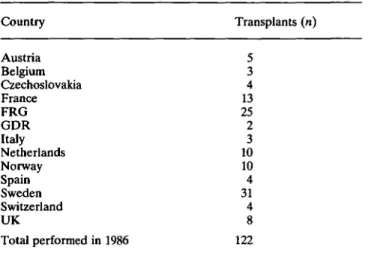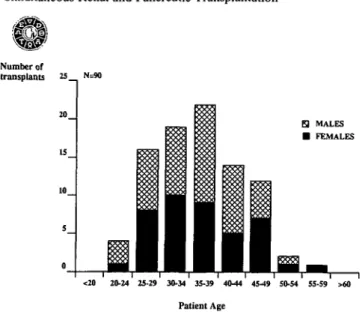Nephrol Dial Transplant (1991) 6: 1-4
© 1991 European Dialysis and Transplant Association-European Renal Association
Nephrology
Dialysis
Transplantation
Registry Report
Renal Transplantation in Diabetic Patients with or Without
Simultaneous Pancreatic Transplantation 1986: Data from the
EDTA Registry
G. Tufveson Transplantation Unit, University Hospital, Uppsala, Sweden H. Brynger Department of Surgery 1,
Sahlgrenska, Goteborg, Sweden E. Dimeny Department of Nephrology,
University Hospital, Uppsala, Sweden
F. P. Brunner* Departement fur Innere Medizin, Universitat Basel, Switzerland J. H. H. Ehrich Medizinische Hochschule Hannover,
Federal Republic of Germany * Chairman W. Fassbinder W. Geerlings G. Rizzoni N. H. Selwood A. J. Wing
Stadtische Kliniken Fulda, Federal Republic of Germany
Stichting Thuisdialyse Noord Nederland, Haren, The Netherlands Ospedale Pediatrico Bambino Gesu, Istituto di Ricerca Scientifica, Roma, Italy
UK Transplant Service, Bristol, United Kingdom
St Thomas' Hospital, London, United Kingdom
Abstract. This report summarises the outcome of 90 combined kidney/pancreatic grafts performed in Europe in 1986. Data for the combined kidney/pancreas grafts were obtained by a special questionnaire. The one-year patient and kidney graft survival is compared to the results of a group of 389 patients with diabetic nephropathy on the EDTA Registry data file who received kidney grafts alone. The recipients of com-bined kidney-pancreas grafts were younger, whereas a greater proportion of males received kidney graft alone. Patient survival at one year after transplantation was similar: 89% in recipients of combined transplants compared to 90% in recipients of kidney grafts alone. Kidney graft survival was 78% at one year for recipients of combined grafts versus 76%. It is concluded that pancreas transplantation has little effect on the fate of concomitant kidney grafts. The procedure should - in
Correspondence and offprint requests to: Professor F. P. Brunner,
EDTA Registry, St Thomas' Hospital, London, SE1 7EH, UK.
experienced hands and in selected patients - be almost as safe as kidney grafting alone.
Key words: Diabetic nephropathy; Combined kidney/ pancreas transplantation
Introduction
Ever since the advent of combined pancreas and kidney grafting in patients with diabetic nephropathy, the advantages and hazards of pancreatic grafting have been a matter of controversy. The impact of pancreatic grafting on patient survival and on the fate of the simultaneously transplanted kidney graft have been discussed extensively [1-4]. In 1984 McMaster and co-workers [4] suggested that combined grafting was not hazardous either to the patient or to the kidney graft. However, this conclusion was based on a small number
of cases. Data presented from the International Pan-creas Registry in Minnesota [5] showed reasonably good kidney graft survival, even though an adequate control group of patients receiving kidney grafts without pan-creatic grafts was lacking.
To analyse further the question of patient and graft survival, the EDTA Registry investigated the results of 90 combined kidney/pancreas grafts performed in 1986 in Europe.
Material and Methods
A total of 122 combined kidney/pancreas transplants performed in 1986 in Europe were brought to the attention of the EDTA Registry through the 1986 centre questionnaire supplemented by information from National Keymen and other sources. A total of 96 special questionnaires were sent in early 1988 to all centres that reported having performed two or more combined grafts in 1986. Information was sought on individual graft recipients concerning sex, date of birth, date of transplantation, date of failure of pancreas/ or kidney graft, date of death, or whether the patient was alive at the end of 1987. Of the 96 questionnaires, 90 (93.8%) were completed and returned.
A control group was selected from the EDTA patient file. This control group consisted of all (389) reported kidney grafts in patients with diabetic nephropathy performed in 1986 in the following countries: Belgium, Denmark, Federal Republic of Germany, Finland, France, Switzerland, and the United Kingdom. Care was taken to exclude patients from these countries who had been subjected to combined kidney and pancreas grafting. Actuarial patient and graft survival rates were computed when the complete patient data up to the end of 1987 were available.
In all instances, standard actuarial methodology was used. Patient death with a functioning graft was counted as graft failure in the calculations.
Results
Table 1 depicts the distribution of the combined kidney/ pancreas grafts in 1986 by country. There was a relative predominance of combined grafts in Sweden and Norway. The remainder of the grafts were performed in Central Europe and relatively few in France, the United Kindgom, and Italy. Because of the uneven distribution of the combined grafts if was felt that a control group of recipients of kidney grafts alone should be restricted to a similar geographical area. However, Sweden and Norway were omitted as it was felt that the remainder of
Report from the EDTA Registry
the diabetic graft recipients in these Scandinavian countries who had not received combined grafts might introduce a bias through a selection of higher-risk patients.
Table 1. Number of combined kidney/pancreatic transplants per-formed in 1986 according to country. In 1986, 26 centres reported performing 122 combined kidney/pancreatic transplants
Country Austria Belgium Czechoslovakia France FRG GDR Italy Netherlands Norway Spain Sweden Switzerland UK Total performed in 1986 Transplants (n) 5 3 4 13 25 2 3 10 10 4 31 4 8 122
Age and Sex Distribution
Figure 1 shows the age and sex distribution of patients who underwent combined kidney and pancreas grafting (Fig. la) and those who received a kidney graft alone (Fig. lb). In general, recipients of combined grafts tended to be younger. The median age at transplant-ation was 36 years for patients with combined grafts and, at 39 years, was slightly greater for recipients of kidney grafts alone (non-significant). Only three patients who received combined grafts were between 50 and 60 years old, whereas 16% of the kidney recipients were aged between 50 and 60 years, and 3% were over 60 years old. The sex distribution of 53% males versus 47% females for recipients of combined grafts differed strikingly from the patients receiving kidneys alone, of whom 65% were male and 35% female.
Patient and Graft Survival
The patient survival is shown in Figs 2a and 2b. It was almost equal in the two groups, with 89% survival at 1 year for recipients of combined grafts compared to 90% for recipients of kidney graft alone. The kidney graft survival also differed little, with a 1-year survival of 78% with combined grafting versus 76% in patients without pancreatic grafts. The pancreas graft survival shown in Fig. 2a was 65% at 1 year.
Simultaneous Renal and Pancreatic Transplantation Number of transplants 25 N=90 H MALES • FEMALES Percent Survival 100 - ^ N=90 -». PATIENT SURVIVAL •ar KIDNEY GRAFT SURVIVAL -». PANCREAS GRAFT SURVIVAL
. 60
<20 20-24 25-29 30-34 35-39 40-44 45-49 50-54 55-59 >60
Patient Age
1 3 Month after grafting
Fig. la. Age distribution at combined kidney and pancreas transplan- Fig. 2a. Diabetic ESRF: Survival after combined kidney and pancreas tation for diabetic ESRF, 1986. transplantation, 1986.
Number of transplants 100 N=389 Percent N=389 Survival 100 E3 MALES • FEMALES <20 20-24 25-29 30-34 35-39 40-44 45-49 50-54 55-59 >«0 Patient Age -»- PATIENT SURVIVAL _ KIDNEY GRAFT SURVIVAL
I I 3 6 Month after grafting
Fig. lb. Age distribution at kidney transplantation for diabetic ESRF, Fig. 2b. Diabetic ESRF: Survival after kidney transplantation 1986. 1986.
Discussion
The present report demonstrates that both patient and kidney graft survival are comparable in patients under-going either kidney transplantation alone or combined with pancreas transplantation. The outcome of kidney transplantation with concomitant pancreas grafting was compared to the results of kidney grafting in patients with diabetic nephropathy who underwent transplan-tation during the same year and who were from a similar geographical area. Although this comparison cannot match the criteria of a randomised study, it nevertheless provides a useful comparison of the two surgical approaches. Details of sex and age distribution suggest
that the two groups are not entirely comparable. For unknown reasons, females appeared to be accepted for combined transplantation at the slightly higher pro-portion of 47% as compared to the 42% female preva-lence with diabetic nephropathy (44% for type I dia-betes mellitus) among patients accepted for renal replacement therapy in 1983-1985 [6]. Similarly, and in contrast to recipients of combined grafts, male patients with diabetic nephropathy were selected preferentially for kidney transplantation alone, as shown by the sex ratio of 66% males versus 34% females. These sex imbalances between the two groups should, in any event, have little influence on patient and graft survival. The results of kidney transplantation have long been
known to be identical or very similar [7] when compar-ing males with females. The difference in age dis-tribution (which is not statistically significant) would be predicted to result in slightly better patient survival in the younger recipients of combined grafts, whilst the effect on kidney graft survival is likely to be small [8]. That no such differences were apparent might be due to the relatively small number of patients included in the present study. Also, the much improved patient survival rates attained in recent years makes detection of small differences very difficult.
As the early postoperative hazards following com-bined kidney and pancreas grafting now appear to be comparable to those of kidney grafting alone, and the kidney graft survival is not adversely affected by pan-creatic grafting, it seems justified to continue to perform combined grafts, at least in surgical units with the appropriate experience [9]. The outcome of pancreatic function in patients undergoing combined grafting is also encouraging, since only 20% of the patients with a functioning kidney graft had lost their simultaneously transplanted pancreas within the first year. Most of the pancreatic graft losses were confined to the first three months after transplantation, and the survival of a pancreas graft alone after kidney graft failure seems to be a rare event (one patient only in this series).
It is the intention of the EDTA Registry to obtain follow-up information on the present cohort of patients with combined kidney/pancreas grafts within 2-3 years, in order to establish any possible beneficial long-term effects of simultaneous pancreas grafting.
Report from the EDTA Registry
Acknowledgements. The work of the EDTA Registry has been
supported by grants from Governments of National Societies of Nephrology. Grants have also been made by the AKZO Group, Asahi Medical Co. Ltd, B. Braun Melsungen AG, Baxter Healthcare Corporation, Bellco SpA, CD Medical International Ltd, Cilag AG Research, Cobe International, Fresenius AG, Gambro AB, Hospal Ltd, and Sandoz AG.
We thank all those doctors and their staff who have kindly completed EDTA Registry questionnaires, and particularly those who completed the special questionnaire on combined kidney/pan-creas grafts that made this study possible.
References
1. Bohman S-O, Tyd6n G, Wilczek H et al. Prevention of kidney graft diabetic nephropathy by pancreas transplantation in man.
Diabetes 1985; 34: 306-308
2. Pyke D. Pancreas transplantation for diabetes? Lancet 1988; 1: 816-817
3. Sutherland DER. Who should get a pancreas transplant?
Dia-betes Care 1988; 11: 681-685
4. McMaster P, Michael J, Adu D et al. Combined kidney and pancreas grafting - is it really safe and does it jeopardise the kidney? Transplant Proc 1984; 16: 704-706
5. Sutherland DER, Moudry KC, Fryd DS. Results of pancreas transplant registry. Diabetes 1989; 38 [Suppl 1]: 46-54
6. Brunner FP, Brynger H, Challah S et al. Renal replacement therapy in patients with diabetic nephropathy, 1980-1985.
Neph-rol Dial Transplant 1988; 3: 585-595
7. Brunner FP, Wing AJ, Dykes SR et al. International review of renal replacement therapy: Strategies and results. In: Maher JF, ed. Replacement of Renal Function by Dialysis. Kluwer Academic Publishers, Dordrecht, Holland, 1989; 697-719
8. Brunner FP, Broyer M, Brynger H et al. Survival on renal replacement therapy: Data from the EDTA Registry. Nephrol
Dial Transplant 1988; 3: 109-122
9. Groth CG. Pancreas transplantations. Lancet 1988; 1: 1400
Received for publication 16.5.90 Accepted in revised form 10.10.90

